10 Most Famous 19th Century Paintings
The 19th century was a time in which many artists began to produce notable works using various new methods of painting. Impressionist artists frequently left the condolement and solitude of their studios to venture out into public or to a afar location to paint a landscape.
France was the epicenter for much of the century's most famous artists and art movements as Paris was a hotbed of artistic thought during this time.
Unlike centuries earlier the 1800s, artists began to explore methods of painting that reflected more nigh their own inner feelings toward the bailiwick rather than how the subject itself actually appeared.
Realism gave ascent to Impressionism and other styles of painting emerged in the latter part of the 19th century that focused heavily on the many unlike perspectives that are so often ignored in ii-dimensional image paintings.
The art of the 19th century was equally vibrant every bit whatsoever in man history and the era produced some of the about famous painters to ever agree a brush. This listing compiles some of the most famous 19th century paintings from an era that truly transformed art as nosotros know it.
19th Century Paintings
1. Woman with a Parasol – Claude Monet
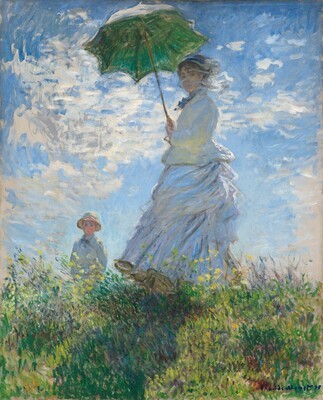
Claude Monet was a masterful Impressionist painter who normally focused on the female course while fully dressed in the outdoors. His piece of work titled Adult female with a Parasol is one that highlights his incredible power to portray the lord's day's captivating effects on a adult female as she stands on a windswept hillside property a parasol, which was common for women to carry at the time.
The majority of Monet's paintings were painted 'en plein air' or outside in nature, he would routinely paint the same scene multiple times in varying light conditions, there is only i Woman with a Parasol though.
Monet painted the work in 1875 and he later noted that the young child in the scene is the woman's son who is seen curiously looking toward the viewer.
Monet is best known for his utilize of bright, colorful hues to portray people in the midday sun. This item painting is a notable combination of calorie-free and shadow as the viewer sees very little surfaces that are experiencing direct sunlight.
Instead, we take an prototype that's shadowed and features sweeping edges as if to bespeak the wind'southward strong event on this fleeting moment. Monet subsequently said that it was his intention to portray a casual family outing instead of a rigid and more formal portrait.
ii. Liberty Leading the People – Eugene Delacroix
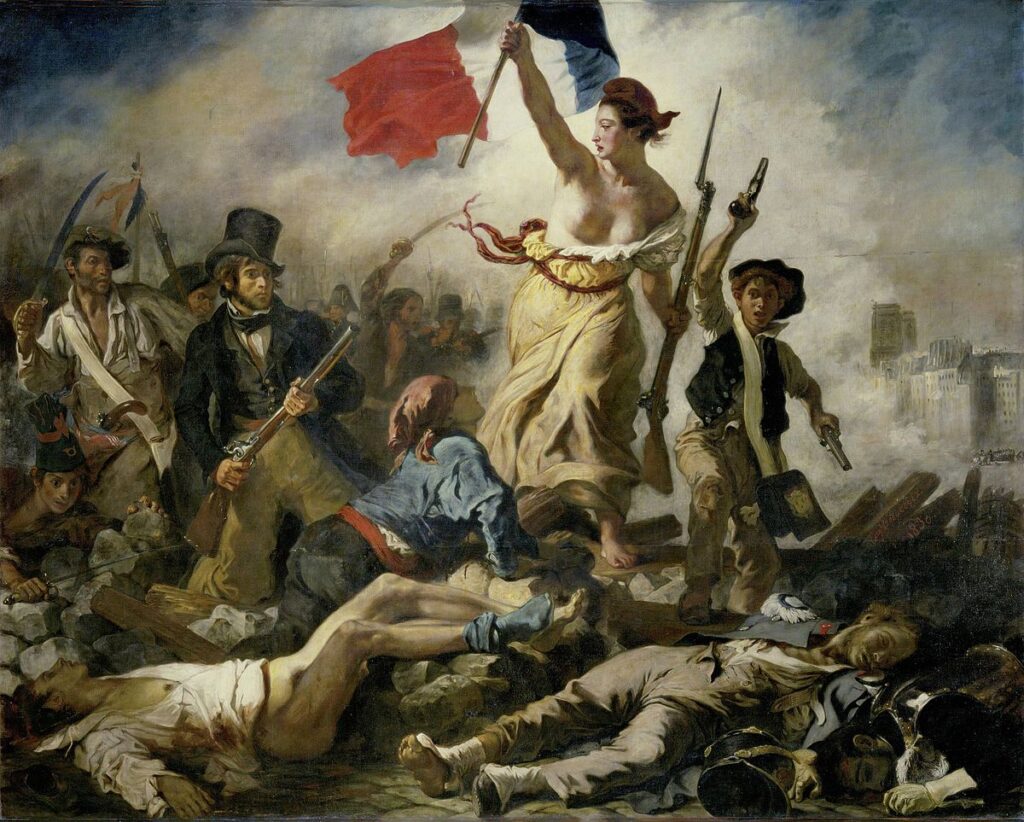
The French Revolution was i of the nearly volatile times in European history. The events of the lesser known July Revolution took identify in the summertime of 1830 and saw less violence, only an overwhelming amount of passion from the French people to topple what many viewed as an undeserving monarch.
Eugene Delacroix painted his work titled Liberty Leading the People that same year equally an effort to urge the people of France to press on toward total liberation from the monarchy that had constricted their freedoms for so many years.
The painting depicts a valiant charge of ordinary French men armed with muskets. At their front is a beautiful female person figure, frequently referred to as Marianne, who represents the France. She is adorned in a dress that merely half-covers her body while holding the French flag and a musket, appearing to beckon the men to accuse onward over the fallen king's soldiers.
This work has long been viewed as one of the most iconic French works of art and is widely considered ane of the nearly famous paintings of the 19th century.
3. The Gleaners – Jean-Francois Millet
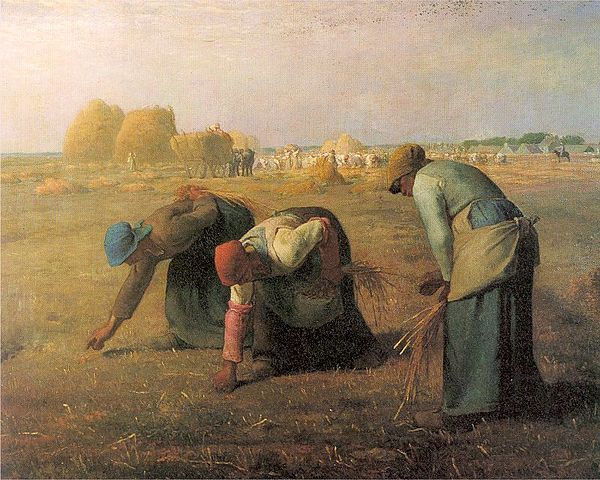
Jean-Francois Millet is known equally one of the well-nigh famous artists of the Realism motion that took place in Europe during the mid-1800'south. His works commonly focused on peasants and the mutual French denizen who often spent every waking hour of each solar day working to scrounge what they could to get by.
His painting known as The Gleaners is one that encompasses his efforts to bring to light the struggles of the poor French peasant course among a time when the elite lived in much amend conditions.
The painting depicts 3 peasant women gleaning, or collecting crops that had been left behind by those who initially harvested the field. The very human action of gleaning was i that peasants were very familiar with and information technology was considered ane of the virtually undesirable jobs in the French farming culture at this fourth dimension.
This piece of work accomplished the goal the Millet likely intended of highlighting the harshness of life for many French peasants during the 19th century.
4. Dejeuner sur l'Herbe – Edouard Manet
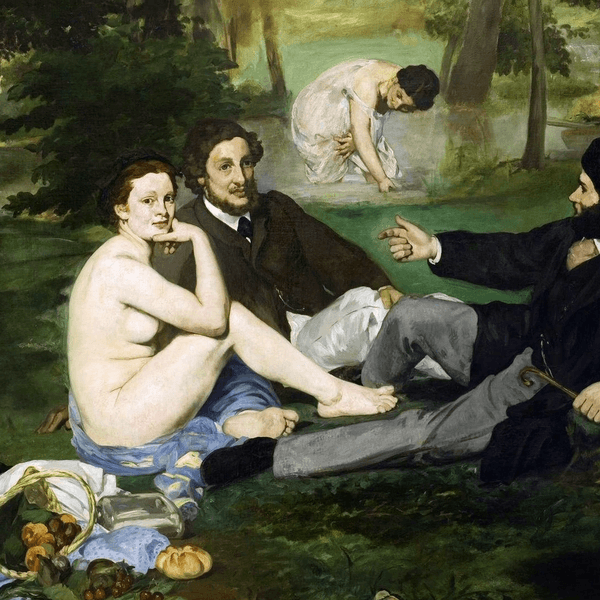
Edouard Manet is considered a unique artist during the 19th century who managed to span the gap betwixt Realism and Impressionism through his works.
He commonly focused on the female person form in a natural setting and his painting titled Dejeuner sur l'Herbe, or The Bath, was initially known as Luncheon on the Grass. Painted in 1863, Manet received quite a flake of backlash from art critics at the time for what they deemed to be the lewd nature of the work.
The painting features a nude adult female lounging with two fully-clothed men in a wooded woods while another woman in the background is seen bathing. It's controversial nature is perhaps why is has remained as a central work of French mastery and one of the most famous paintings of the era.
five. The Raft of the Medusa – Théodore Géricault
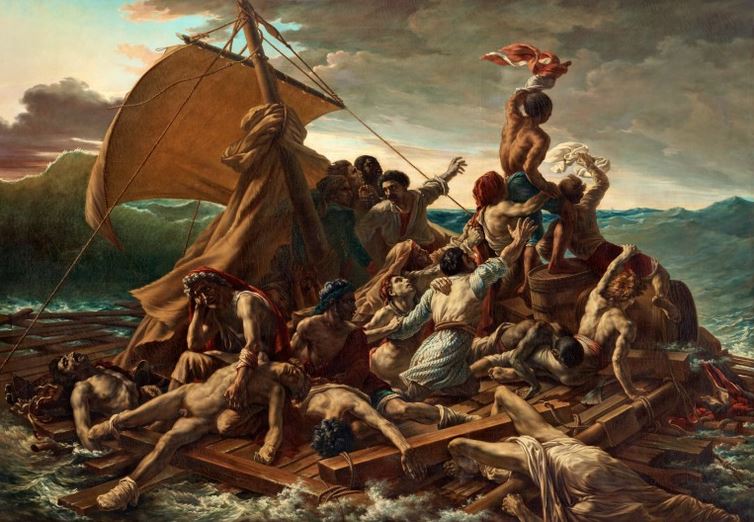
I of the most famous paintings in the French Romanticism movement is known every bit The Raft of Medusa. Painted by Théodore Géricault in 1819, this work features a grisly scene of sailors who were the only survivors left from the shipwreck of the French naval frigate known equally the Medusa.
The artist sought to commemorate the lives of the sailors that were lost in the accident and painted the scene in a darkened, bleak colored manner that seemed to denote the gravity of their situation while lost at sea.
The incident was 1 that drew high amounts of worldwide criticism due to the belief that the French naval command acted in a way that put the men's lives in danger. Géricault's painting was viewed as a fitting way to honor the men.
half-dozen. Cafe Terrace at Night – Van Gogh
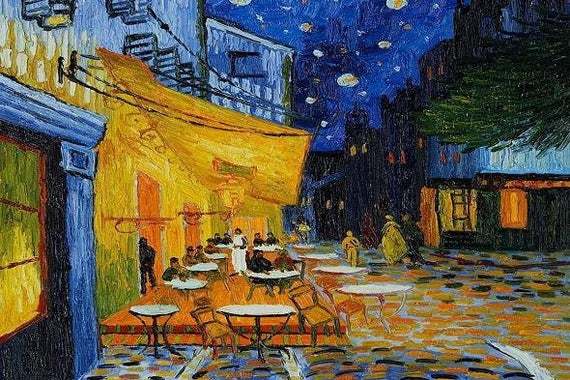
Few 19th century artists are as well-known as Vincent Van Gogh. Despite his struggles with mental illness, he was hailed as 1 of the most masterful painters of the time menstruation. His work titled Cafe Terrace at Night was painted in 1888 and featured a scene of the quaint street in the latter hours of the evening.
The street and the buffet are illuminated past a warm, yellowish lite that seems to emit a welcoming glow toward anyone who knew the popular location.
The work was 1 of the nearly famous cityscape paintings by Van Gogh who would subsequently be faced with a bout of serious low and bipolarism which took an immense toll on his concrete condition.
7. The Lady of Shalott – John William Waterhouse
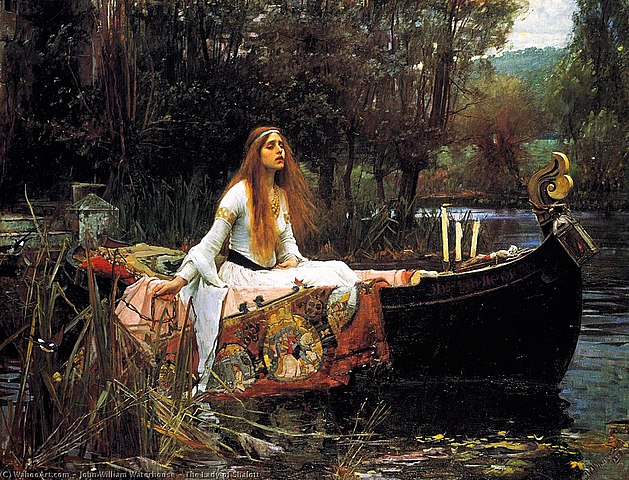
John William Waterhouse is an artist from the 19th century who was known for his high attention to detail and his ability to portray scenes in a vibrant and lifelike manner.
His 1888 work titled The Lady of Shalott is widely noted as ane of the nigh famous paintings from the fourth dimension period as it represents the ending of one of Lord Alfred Tennyson's poems which bore the same proper name as the painting.
The painting drew considerable amounts of praise as Waterhouse showcased his power to paint a scene with such beauty that seemed to harken back to the Italian Renaissance period. The Lady of Shalott is seen in a boat that is globe-trotting along a serene lake, just every bit Tennyson's verse form describes.
8. Lunch of the Boating Party – Pierre-Auguste Renoir
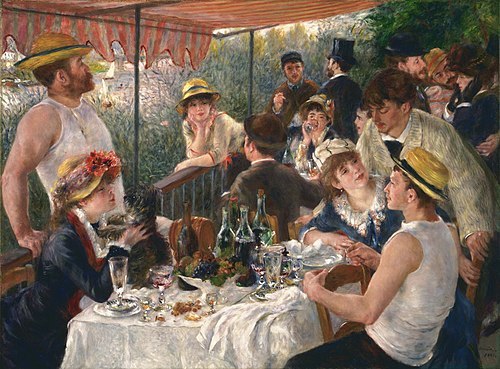
Many artists painted scenes from the bustling Parisian social scene that took place during the last few decades of the 19th century. Few would produce works that were able to capture it in a more moving fashion than Pierre-Auguste Renoir, who was known for his ability to paint jovial social interactions betwixt young and affluent French people of the time period.
His painting titled Luncheon of the Boating Party depicts a group of Renoir's friends relaxing in the warm midday setting of the Maison Fournaise eating house, which was a popular destination in 1881 when the piece of work was finished. This work features the same vibrant color arrangement that most of Renoir'due south paintings were famous for using to portray the thriving social life of many young French citizens of the time period.
9. The Absinthe Drinker – Edgar Degas
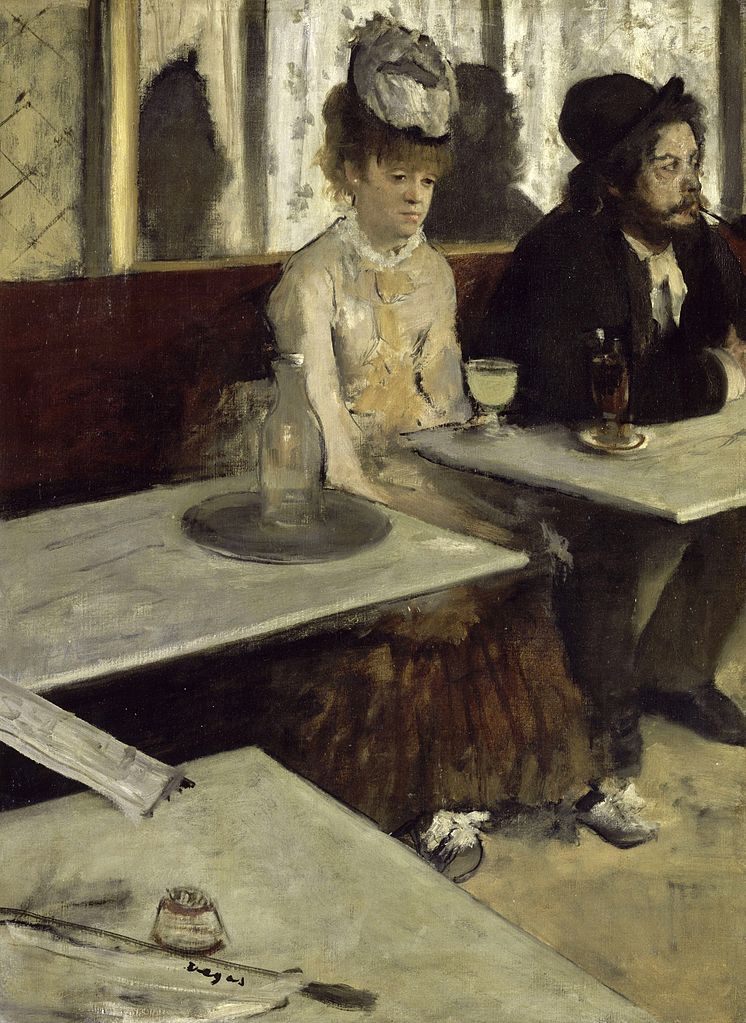
French artistic lodge had its fair share of figures who were considered outsiders amidst the most well-known circles of Parisian artists. Edgar Degas was 1 who received quite a fleck of backlash from amidst his peers for paintings such as his 1876 piece of work titled The Absinthe Drinker.
This painting portrays a human and woman seated side-by-side in a Paris cafe, clearly inebriated by the effects of their drink of choice, which was known to produce feelings of lethargy and a solemn demeanor.
While many well-known painters looked downward on Degas for painting scenes that included drunken individuals, others praised him for his ability to portray French society every bit it actually was during the time.
ten. The Menu Players – Paul Cezanne
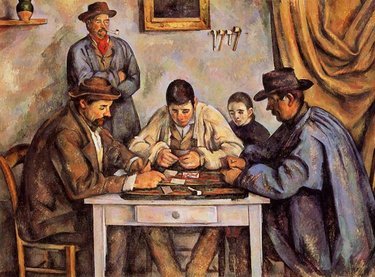
Paul Cezanne is remembered as one of the most famous artists of the 19th century and a primal figure of the Mail-Impressionist motion that took place toward the late 1800s.
His work titled The Card Players was part of a serial of paintings that featured French citizens engaged in everyday activities like carte du jour games and other casual activities.
This item work was done in 1895 and features ii men seated at a small table, playing a game of cards. A bottle of wine sits beside them on the tabular array.
This and other works by Cezanne which featured groups of men and women frequently engaged in coincidental drinking was viewed by many well known art critics of the day every bit unworthy of being featured in a painting, particularly by a historic artist similar Cezanne.
These works by Cezanne were noted as being "human all the same life" works as they ofttimes portrayed men engaged in card games as they stared intently at their own hand they had been dealt.
marshallsonfe1976.blogspot.com
Source: https://www.artst.org/famous-19th-century-paintings/
0 Response to "10 Most Famous 19th Century Paintings"
Post a Comment